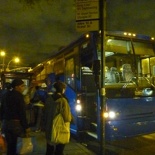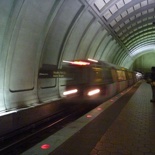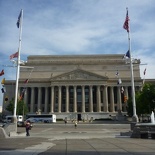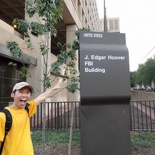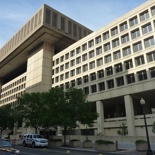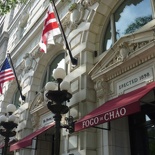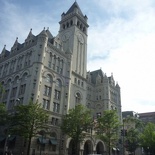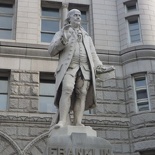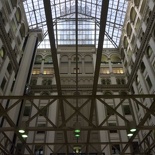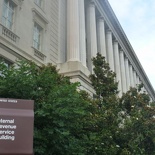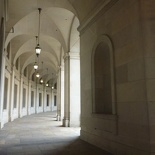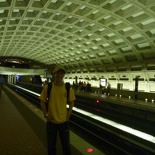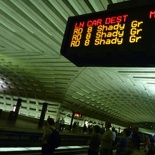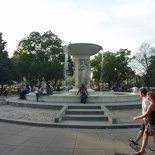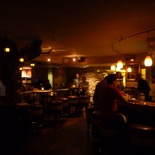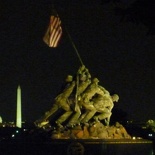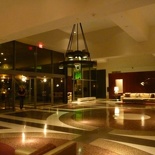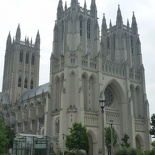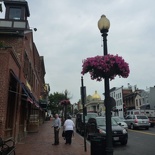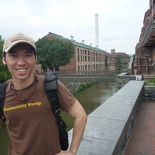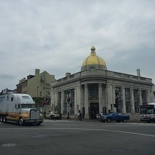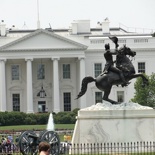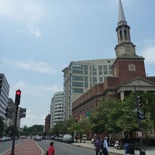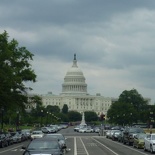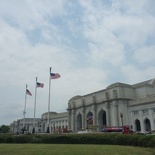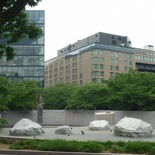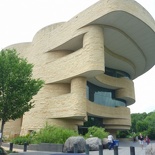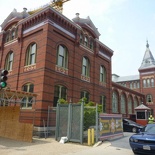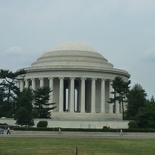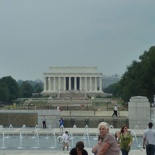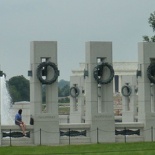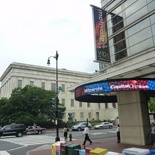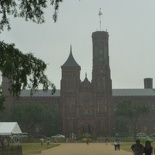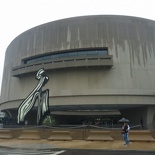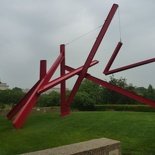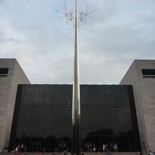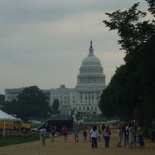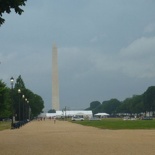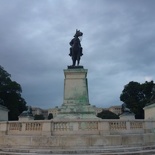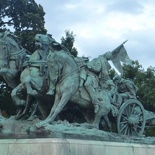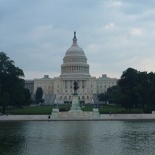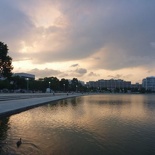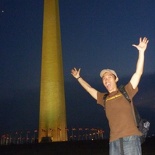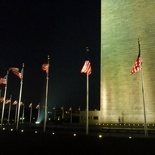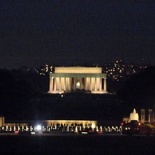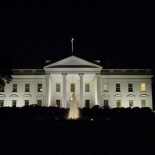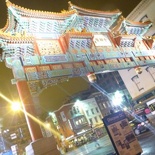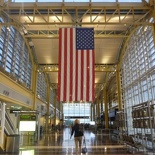Washington, D.C. is formally known as the District of Columbia (D.C.) and commonly referred to as Washington or simply just “The District”. My trip in Washington starts with an overnight 11pm bus ride over from downtown New York. Besides domestic air travel, you could be better off taking an overnight bus between neighboring states, saving you the cost of an overnight day at a hotel or inn, but at the expense of some of your sanity from jet lag and sleep interruptions on the bus on the rest stops, not that a little coffee can’t fix!
The departing bus arrived earlier than expected right at 3am in D.C, much to over dismay as none of the public buses are not operating yet at that hour. After our own variation of Sega’s Crazy Taxi on the empty streets of Washington with our own scary reckless taxi driver beating 2 red lights and making several illegal turns, we arrived at the Washington International student center in one piece and in record time too. The center is like a backpacker’s inn run by students in the area, where we will be spending our stay here in D.C. It offers traveling students from all over the region affordable rates to stay. It didn’t take long for us to get all our stuff unpacked in our rooms and out sightseeing by the crack of dawn.
There is alot to see here in Washington, and if you are a museum and monument enthusiast then this is the place for you. Most of D.C attractions and museums are all located along the National Mall and Pennsylvanian avenue, leading up to the US Capitol. They are all linked by an extensive network of underground rail network operated by D.C Metro. The Metro is the best way to travel here in D.C. The operating trains and stations here are modern, fast, clean and rather well maintained compared to those in New York. Even the stations themselves look rather space age, almost like a subterranean scene from the underground bunkers of a secret organization, or maybe just the Men in Black for keeps.
Popping up at the Archives metro station will bring up right up to the US Navy Memorial, which sits in front of the National Archives building, this major road in front of us is Pennsylvanian avenue which links the White House on the western end and the US Capitol on the other. The Newseum (news museum) also resides here which I will cover in more detail in my following blog post.
Moving westbound to the intersection on 10th street is the Federal Bureau of investigation (FBI) headquarters. The FBI is no stranger to anyone with their main roles bring both a federal criminal investigative body and an internal counterintelligence agency. Their non-exhaustive line of duty involves preventing terrorist attacks, protecting civil rights and investigating technological treats to the US, just to name a few. The front of the building is decked out by lines of American flags and entry is via invitation only. Ironically, the building was named after one of the FBI most prominent heads, the late J Edgar Hoover, who believe it or not, actually hated the design of the FBI building, man he won’t be pleased.
The streets here are literally like history in motion, with historical finds at every single block. Moving off 12th street is the Old Post Office and Clock Tower, with the statue of Benjamin Franklin standing in front of it. The building served as a focal point for the US postal services in Washington when it was completed in 1899. The post office is the largest commercial building and standing 82m at the top of the tower’s observation deck, it is the third tallest structure in Washington, D.C.
It was officially renamed the Nancy Hanks Center in 1983, operated and maintained by the National Park Service rangers from the Pennsylvania Avenue National Historic Site. Despite it actually not an operating post office, the building is still largely known here to many locals in Washington as the “Old post office” and it still bares the Post Office name outside it’s front entrance. It is now converted to a shopping mall and food court and is accessible to the public after some light security screenings. National parks do provide tours of the Old Post Office Tower with exhibits including a room depicting the building’s long struggle for survival. The bell tower, besides providing spectacular views of the Washington city from the top is also home to The Bells of Congress which are replicas of those at Westminster Abbey.
Walking along 12th street leads you right to the Federal Triangle Metro Station where the (Dun dun dun) Internal Revenue Service reside. I guess to most Americans, saying the word “IRS” just brings the chills to anyone’s spine, being right next to the building itself is even more scary. The Federal triangle metro station here is also home to one of the major interchange for the blue and orange lines of the D.C. Metro.
The stations here are all situated rather deep underground, with escalators going like 5 to 6 floors or more underground before coming onto the station platforms, any longer and the escalator ride will lead you right to the center of the earth. All D.C metro stations are also thankfully wheelchair accessible and travel is done via the metro D.C travel pre-paid Metrorail and Metrobus travel card. The prices for single trip travel depends on the station you are traveling too, so for visitor (or tourist) who do not want to invest in a dedicated card have the option for a single day pass, which is recommended, not to mention more bang for the temporary buck. Despite all the stations here looking pretty much the same, like someone with a wardrobe malfunction, the monotonous look is actually rather modern; with iconic parabolic concrete tiles lining the perimeter walls on most of the stations here in the D.C. Metro. The platform edges even have this cool red lights which pulses with increasing intensity when the train is arriving.
After checking out various museums along the national mall and the Newseum, we are up in the National gallery of art, where it is home to few iconic art pieces such as those by Leonardo di Vinci. Calling it the National Gallery does give it some high expectations to meet, the museum does spot few nice galleries, but just does not leave one saying “wow” at the end of the day. The museum itself does not quite match up to the expectation of “national”, particularly in comparison to the caliber of the art “national” art museums I’ve visited, particularly those in Paris.
Dinner was up at Dupoint circle with another friend from Harvard University. We very much GPS-ed our way around town courtesy of Google maps on AT&T mobile internet before ending up at Fireflys’ pub for dinner. The restaurant in question is located on New Hampshire Ave just by Hotel Madera. Here we had seafood and delicious soft shell crabs for dinner. We metro trained our way to Rosslyn Metro Station thereafter to spend the night at the Iwo Jima Memorial, with spectacular views of the memorial in the garden overlooking the US Capitol and Washington Monument all lit by a cloudless sky and full moon that night.
The Iwo Jima War Memorial (Marine Corps Memorial) is located in a large public park just off Marshall Drive, next to Arlington National Cemetery and is dedicated to the marines who gave their lives during one of the most historic battles of World War II, the battle of Iwo Jima. The area is well served by buses and spots a large carpark on the park perimeter if you are driving there from Key’s Bridge. Otherwise it’s a walk south across the Arlington Boulevard highway before hitting the park, if you are headed from the Rosslyn D.C. Metro Station.
Crystal city is a surprising little underground “city” or sort, one which can literally spend your whole time underground without having to surface above ground level at all. The metro serving the station is interconnected to underground shops which in turn serves most of the residential areas in this city through these linking tunnels. It so as we come to learn after spending the night at our friend’s apartment, where she showed us around her apartment in Crystal City till late, with us barely making the last train back in time to the student center.
Our next full sightseeing day involves getting on the D.C hop on and off trolley tours around various unreachable areas of D.C not well served by the Metro rail or bus system itself. The trolleys in question here are the Orange D.C. trolley tours and they are a good way to get around the remote attractions of Washington D.C, such as the neoclassically gothic Washington National Cathedral. The cathedral here is one of the of the Episcopal Church and it is huge. In fact it is the 4th tallest structure in Washington, D.C., the 6th largest cathedral in the world and the 2nd largest cathedral in the United States. It receives about half a million visitors a year and spots a congregation number of 800.
It’s a drop off at Georgetown for some Sichuan Chinese lunch in a nearby food court just off the Potomac River. Founded in 1751, Georgetown itself is a neighborhood located in the Northwest quadrant of Washington just along the Potomac River waterfront. The town retained its separate municipal status until 1871 and now is an establishment of the city of Washington and the District of Columbia, this was only after it was eventually accepted by the United States Congress.
Georgetown is also home to Georgetown University as well as many commercial high-end shops, bars, and restaurants littered along M Street and Wisconsin Avenue in this sector of the old town. It’s at the intersection between this street and avenue where the former Riggs Bank building now stands. Our uptown tour carries on southwards towards downtown, passing by numerous embassies which just keep appearing out of nowhere along embassy avenue, before making a short stop in front of the White House north lawn. Thereafter it’s all downtown, passing by several national monuments off Arlington in the District of Columbia itself.
The New York Avenue Presbyterian Church located on F Street is widely known as the President’s church, as it’s one which almost all United States president attend during his term in office. Tales foretold, many say that the old lap bars located just across the street from the Church are the exact same ones which Abraham Lincoln used to tether his horse to when he attends service in this Church. The church itself was formed in 1859. Moving on along Pennsylvania Avenue east bound past the Capitol brings us to one of the busiest and best-known places in Washington, D.C. the Union Station.
Opened in 1907, the Union station was designed to be a grand ceremonial train station and entrance to Washington D.C in the early days of rail travel. With a current annual visitation of 32 million, the station itself is a rather busy one too. It is the headquarters of country-wide Amtrak and is served by MARC, VRE and of course Amtrak commuter railroads. This too includes the Washington Metro transit system of buses and subway trains.
Moving down westbound will bring you past the Japanese American Memorial located just off the road by the Capitol. Several Smithsonian Institution museums such as the Air and space museum as well as the National Museum of Natural history can be seen along MadisonDrive. The National Museum Of The American Indian is an interesting museum, the museum itself is new but it was purposely weathered on it’s exteriors to make it look dated with the earthy tribal Indian theme which it showcases.
Just off marine Avenue towards the Tidal Basin sits the Thomas Jefferson Memorial. Here, bridges serves the roads leading up to the Arlington county. The Jefferson Memorial is a presidential memorial dedicated to Thomas Jefferson, the third President of the United States and said to be an American Founding Father.
The neoclassical Jefferson Memorial was built over a period of 5 years. It was completed in 1943 by Philadelphia contractor John McShain, and was designed by John Russell Pope. The bronze statue of Jefferson was added in 1947 after the world war. The Memorial itself is one of the few rather popular monuments out of downtown Washington and is presently managed by the National Park Service’s National Mall and Memorial Parks division.
Similarly, The Lincoln Memorial at the western end of the National Mall across the Tidal Basin was built to honor Abraham Lincoln, the 16th President of the United States. It takes the form of a Greek Doric temple designed by architect Henry Baconand and contains a large seated sculpture of Abraham Lincoln (made by Daniel Chester French) and inscriptions of two well-known speeches by Lincoln, including The Gettysburg Address and his Second Inaugural Address. You may recognize the memorial being backdrop and site for various famous speeches, such as Martin Luther King’s “I Have a Dream”.
Everything here in Washington DC is monumental, well literally, there always seem to be a memorial or monument for almost every part of history you can think of here. The National Mall and Tidal basin is home to a few more notable smaller ones, including the nearby Vietnam Veterans Memorial, Korean War Veterans Memorial, and National World War II Memorial. When I was there, the new and upcoming World War I memorial can be seen constructed just off the road leading up to the Lincoln Memorial. Almost all of these memorials are administered by the National Park Service under its National Mall and Memorial Parks group. Heading into downtown past Chinatown is The Verizon Center. This iconic indoors sport arena, beside being named after the telecom company is home to the Washington Wizards for NBA, the Washington Capitals of the NHL, the Washington Mystics of the WNB and even the sport grounds of the nearby Georgetown University men’s basketball team.
Having mentioned the National mall, the National mall itself is unlike what the name suggests is a large open field which runs from the Washington Monument to the front of the Capitol, offerings views of either structure on both ends of the National Mall itself. The mall itself is a popular spot for open air outdoor events and seasonal carnivals. The distinctive red stoned Smithsonian castle can be seen right along the center Mall, flanked by many other Smithsonian museums along the field itself.
Various museums line the side of the National Mall which runs parallel to Constitution Ave. Moving along this avenue will bring you past the National Museum of American History as well The Hirshhorn Museum with the Hirshhorn Sculpture Garden out front. The Hirshhorn Museum contains over 6000 paintings and sculptures from the nineteenth and twentieth centuries as donated to the Smithsonian Institution, including a $5 million endowment by Joseph H. Hirshhorn upon his death in 1981. Hirshhorn made his millions when he became a stockbroker in 1916 after starting out working as an office boy on Wall Street at age 14. The museum has both indoor and outdoor exhibits, namely those inside the Museum itself and those in the Sculpture Garden. The museum opened in 1974.
The Smithsonian Natural History and the Air and Space museum sits along this stretch which are all managed by the world-renowned Smithsonian Institution. I will be covering each of the main museums here in Washington, particularly some of the iconic Smithsonian ones in more detail on my following posts in my east coast trip which follows, in the meantime lets get a move on along the National Mall to the US Capitol.
The Capitol is accessible by buses along Pennsylvania Ave or from Constitution Ave. The closet Metro station is the ASID stop on the Metro Blue line. Otherwise you can walk east bound from the National Mall after visiting the museums in the vicinity. The National Mall itself spans 2 kilometers east-west with the Capitol on the east and the Washington Monument towards the west, so it’s still largely a very walkable distance. The World War II and Lincoln Memorial sits beyond the Washington Monument another kilometer away. The mall is a rather pleasant walk in the park. You might come across many joggers around the area as well as students or associations playing baseball on the various green fields on the National Mall fields itself.
The United States Capitol is 5 floored complex which sits atop Capitol Hill at the eastern end of the National Mall near Garfield Circle. It’s Senate wing was completed in 1800 and the House wing 1811 respectively. The Capitol is primarily used as the meeting place of the United States Congress, the legislature of the federal government of the United States. You can tell whether congress is in session by the raised state flags sitting on the top of both wings of the Capitol. The front of the building’s west facade sits the capitol’s reflecting pool and is flaunted by several war Equestrian statue which makes up the Ulysses S. Grant Memorial.
Just on the south end of the west entrance of the capitol is the United States Botanic Gardens. The 5 acres Botanic Garden is a national greenhouse and first opened it’s doors in 1816. It is the oldest continually operating botanic garden here in the US and is supervised by the Congress and designed by the Architect of the Capitol, who is also responsible for maintaining the garden grounds of the United States Capitol too. The gardens are open every day of the year, including federal holidays.
The Washington Monument on the other west end of the National Mall here in Washington is a 170m tall obelisk and the world’s tallest stone structure and obelisk. Accessible via the Smithsonian Metro station, it was constructed out of marble, granite, and bluestone gneiss in commemoration to George Washington, the first U.S. president. It’s from up here on the high grounds of the Washington monument where you can see the Lincoln memorial and White House lit up just north from afar. The presidential south lawn pretty much obscures much of the iconic white mansion, so the best way to see the White House is to actually take the Metro to the White house grounds, where you are able to access the front gardens offering north view of the mansion with it’s front northern fountain.
The White House itself is a large mansion located at 1600 Pennsylvania Avenue between McPherson Sq and Farragut West Metro Station on the blue metro line. It is the official residence and principal workplace of the U.S President. The white-painted Aquia sandstone mansion has been the residence of every U.S. President since John Adams. It was designed by Irish-born James Hoban and constructed between 1792 and 1800 spotting a rather Neoclassical style which takes it’s origins form France.
The front of the White House is relatively open and rewards with a nicely lit view of the mansion in it’s white glory though the north presidential gardens and fountain. The north lawn is out of bounds to the public, but the Pierre Charles L’Enfant designed Lafayette Square is public accessible. The square was also humorously labeled as the park with densest squirrel population known to science.
It is a 7 acre garden which makes up the northern half of the President’s Park. It was named in honour of Marquis de Lafayette, the Frenchman who fought in the American Revolutionary War. The four corners of the square stands statues of foreign Revolutionary War heroes comprising of Major General Marquis Gilbert de Lafayette himself, Major General Comte Jean de Rochambeau of France, Brigadier General Thaddeus Kosciuszko of Poland, and Major General Friedrich Wilhelm von Steuben of Prussia.
The Pentagon itself can be seen just outside the Pentagon Metro stop. Security is very tight there and photos were not allowed on the Pentagon grounds. The Chinatown here in Washington, D.C. is a rather small town comprising of just a handful of Chinese and small Asian businesses, comprising of shops and restaurants along H and I Streets between 5th and 8th Streets. The town itself is a historic neighborhood east of downtown and is known locally here for its annual Chinese New Year festival and parade. The Friendship Arch is a Chinese gate built over H Street at 7th Street, marking the start of this little town. You will see it immediately upon exiting the Chinatown Metro stop.
Overall, Washington is a rather fresh getaway and is also a rather popular destination for Americans who travel domestically and for most, it’s getting in touch with their country’s history and achievements. The city in all is very well kept, clean and maintained. I am glad to say that it’s also one of the safest states I’ve ever visited here in the United States.
- New York City & Brooklyn (Photos: New York City & Brooklyn)
- New York Hudson River Cruise, Wall street and Rockefeller Center
- American Museum of Natural History (New York) (Photos: AMNH)
- Washington D.C. (Photos: Washington D.C.)
- Newseum, Washington DC (Photos: The Newseum)
- National Gallery of Art, Washington (Photos: National Gallery of Art)
- Arlington National Cemetery, Washington DC (Photos: Arlington National Cemetery)
- Smithsonian Natural History Museum (Photos: NMNH)
- Smithsonian Air and Space Museum (Photos: Air & Space Museum)
- Orlando, Florida & Magic Kingdom at Walt Disney World Resort (Photos: Disney Magic Kingdom)
- Orlando Disneyland Hollywood (MGM) Studios (Photos: Disneyland Hollywood Studios)
- NASA- Kennedy Space Center, Merritt Island, Cape Canaveral (Photos: Kennedy Space Center)
- Islands of Adventure, Orlando Florida (Photos: Islands of Adventure)
- Universal Studios Orlando, Florida (Photos: Universal Studios Orlando)
- Miami Florida, South Beach and Aventura mall (Photos: Miami Florida)
- Pittsburgh, Pennsylvania (Photos: Pittsburgh, Pennsylvania)
- Cedar Point coaster kingdom, Sandusky Ohio (Photos: Cedar Point)

